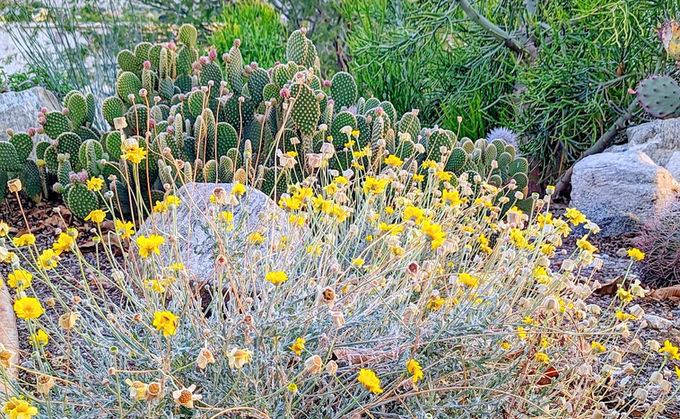We're open for the Season!
Nursery Hours for October-March
Thursday-Saturday: 9:00-5:00 • Wednesday/Sunday: By Appointment
🌲🌲🌲Holiday Schedule🌲🌲🌲
Thanksgiving: Thursday & Friday CLOSED • Saturday OPEN 9:00-5:00
Christmas: 12/23/2025-01/07/2026 CLOSED
Desert Marigold
Baileya multiradiata
true
1 gallon
Desert Marigold
In stock
2’x2’
Sizes:
Desert Marigold – Baileya multiradiata
Also known as: Paper Daisy; Desert Baileya
Desert Marigold is a tough, short-lived perennial or biennial native to the southwestern United States and northern Mexico. It is especially common in the Sonoran and Mojave deserts, where it thrives in full sun and rocky or sandy well-drained soils. With a low-growing mound of silvery-gray, finely divided foliage, this plant produces brilliant golden-yellow daisy-like flowers on tall, slender stems. The blossoms are held high above the foliage and bloom nearly year-round in favorable conditions, with peak displays in spring and early summer.
Topping out at around 12 inches tall and spreading up to 2 feet wide, Desert Marigold is ideal for compact spaces, mass plantings, rock gardens, and roadsides. It is extremely drought-tolerant and thrives in hot, dry conditions. Overwatering can cause rot, so it's best suited to landscapes with infrequent supplemental irrigation. Although it is relatively short-lived, it reseeds freely, allowing colonies to persist in the landscape with minimal maintenance.
This native wildflower is not only visually striking but also ecologically important. The small, accessible flowers are well-suited for a variety of pollinators and are a reliable nectar source in desert environments, particularly during times when few other native plants are in bloom.
Wildlife Value
Host Plant: —
Nectar Source: Monarch (Danaus plexippus); Queen (Danaus gilippus); various species of Blues (family Lycaenidae); Nymphalids (family Nymphalidae); Metalmarks (family Riodinidae)
Bird Resources: Seeds
Bird Species: Mourning Dove (Zenaida macroura); White-crowned Sparrow (Zonotrichia leucophrys)
Plant Care
Native region:
Local Native; Mojave Desert
Water needs:
Low
Exposure:
Full Sun
Mature size:
2’x2’
Growth rate:
Moderate-Fast
Flower color:
Yellow
Flower season:
Year-Round
Pruning:
Shear off spent flower heads and old growth
Cold Hardiness:
5 Degrees
Nectar-producing:
Yes
Attracts pollinators:
Yes
Nighttime pollinators:
No
Butterflies or Moths:
Yes
Monarchs:
Yes
Larval host:
Yes
Bees:
Yes
Bats:
No
Birds:
Yes
Nest site:
No
Nest materials:
No
Rabbit-resistant:
Yes
Tortoises:
Yes
Growing Plants in the Desert — Important Information
The information presented here is, to the best of my knowledge, accurate and based on reliable research, personal experience in my own garden, observations from other gardens I’ve visited, and time spent studying plants in their native habitats. I always welcome your feedback and experiences to help me continue educating others!
Cacti:
In my experience, cacti are much happier in filtered shade here in the low desert of the Coachella Valley. Their colors are more vibrant and they tend to bloom more profusely, especially the non-native varieties. If you look closely at how our native barrel cactus and beavertail prickly pear grow in the wild, you’ll often find them tucked among rocks or beneath the shelter of creosote and other shrubs.
⚠️ A note of caution: Cacti and succulents are often illegally collected from the wild, which not only damages plant populations but also disturbs entire ecosystems. In some cases, wild populations of cacti have even gone extinct because of this practice. When purchasing these plants, always be sure they’ve been legally obtained. Look for nursery-grown stock or plants with a native plant certification, and keep that documentation for your records.
Light Requirements:
In our desert (Sonoran/Colorado), “full sun” doesn’t always mean what you might think. Many so-called full-sun plants benefit from and actually appreciate some late-afternoon filtered light—especially during the intense summer months.












